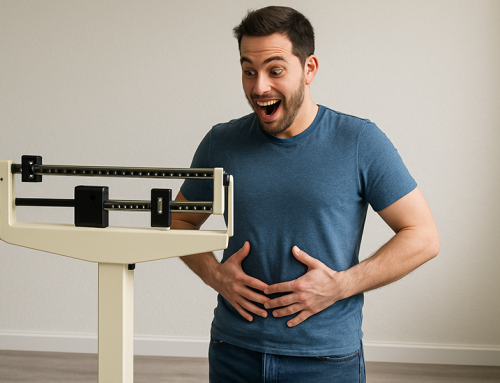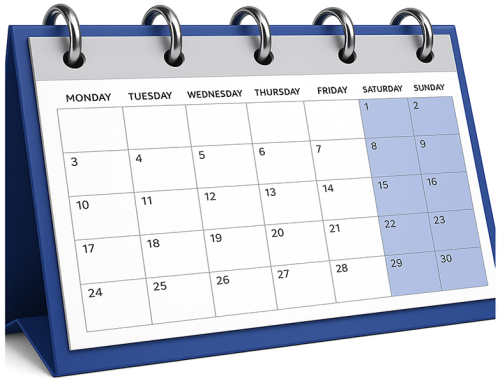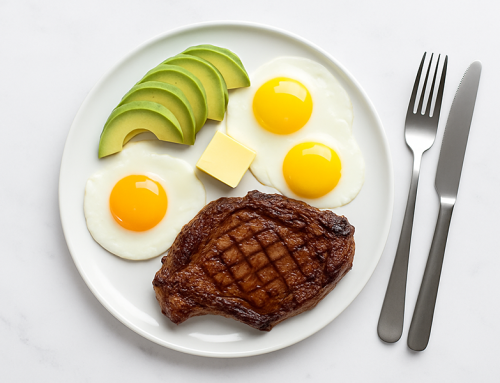You may have heard that muscle burns more calories at rest than fat does. It’s true. Three times as much.
You may have also heard that when you build more muscle, you’ll increase your metabolism. You might have even heard it phrased as, “With more muscle, that means you’ll burn more calories, even while you’re sleeping or lounging on the couch.” Technically that’s true too. But warning: don’t get too excited yet.
You may have even heard the specific claim that each pound of muscle you add to your body burns 50 more calories per day. That is absolutely not true. It’s a big myth.

How Many Calories Does A Pound Of Muscle Burn Per Day?
While it is true that muscle is metabolically active tissue and it does burn more calories than fat and it could increase your metabolic rate, when you see the actual scientifically calculated number of calories, it’s no longer all that exciting.
The real number is a pound of muscle burns only 6 to 10 calories a day, according to studies on energy expenditure in body tissues and organs and also based on basal metabolic rate calculators.
I’ll circle back to where this number comes from in a moment, but stop and think about this first. If a pound of muscle really burned 50 calories, and if you gained just 10 pounds of muscle – something not that difficult for a man in a matter of months, and even possible for women – you’d be burning an extra 500 calories per day.
Since there are 3500 calories in a pound of fat, in 7 days you would be burning an extra pound of fat without doing anything! Even sitting at your desk, you’d be getting leaner by the week because of this “muscle increases metabolism” effect. Or, much to the pleasure of foodies, you’d be able to eat 500 extra calories of your favorite food while still maintaining your weight – no fat gain.
3500 calories: A pound of fat or 6 pounds of muscle?
It would be awesome if this were true. Unfortunately, it’s not. Burning more fat as a result of building more muscle on top of where you are now simply doesn’t happen to a meaningful degree. The exception is people who gain very large amounts of muscular body mass. That usually only happens in male bodybuilders and weight lifters, and it takes a long time.
Origins Of The Metabolism Myth: 1 Pound Of Muscle Burns 50 Calories
Who originally said that a pound of muscle burns 50 calories per day? Where did it get started? I’m not entirely sure. It might have been a really old scientific study, but I couldn’t find one. I do know that many coaches and experts in the bodybuilding industry have promoted the message that building more muscle is good for many reasons including vanity (looking great), health, and yes, boosting metabolism.
That includes me. I’ve written before that increasing your muscle mass can increase your metabolism. And again, technically it’s true, it’s just that building muscle doesn’t increase resting metabolic rate as much as most people think, and I feel strongly that we finally need to clarify this issue with evidence so we can be realistic about expectations.
This idea hasn’t just come from bodybuilders. We’ve also heard it in the mainstream diet and weight loss industry. Dr. Oz was quoted in Oprah magazine as saying, “Muscle burns about 50 times more calories than fat.” Perhaps he meant 50 calories per pound, but either way it’s incorrect. Muscle burns about 3 times as many calories as fat and nowhere near 50 calories per pound.
In his book 8 Minutes In The Morning diet and fitness guru Jorge Cruise said that his training program would help you “build 5 pounds of lean muscle within the first few weeks, allowing your body to burn an extra 250 calories per day.” Do the math and right there you have it – the 50 calories per pound myth.
In some cases, the same claim is made, but the number is closer to 100 calories per pound of muscle. In the book, Power of 10: The Once A Week Slow Motion Fitness Revolution, the author Adam Zickerman wrote, “Adding three pounds of lean muscle burns about 10,000 extra calories a month.”
Umm… No.. Do the math and you can see that the actual figure is a measly extra 540 calories per month.
We could probably go on and on with example after example, because this is one of those myths that has been spread for years and many people are still saying it today. It simply seems to have been passed along and accepted without fact checking.
Does Building Muscle Boost Your Metabolism? A Look At The Science
What do the facts say about muscle and metabolism? Yes building muscle boosts your metabolism, but it doesn’t boost your basal resting metabolic rate by very much. Above, I mentioned the actual figure is about 6 to 10 calories. Below are the scientific sources where these numbers came from.
But first, a quick recap on metabolism. Your total daily energy expenditure (total daily metabolism) consists of 4 components:
1. Resting metabolic rate (energy burned at rest just to maintain normal body functions)
2. Thermic effect of feeding (calories burned to digest food)
3. Thermic effect of exercise (formal workouts)
4. Non exercise Activity thermogenesis /NEAT (all other physical activity all day long)
A brief introduction to non-exercise activity thermogenesis
Resting metabolic rate usually accounts for most of the total daily energy expenditure at 60% to 75%, except for highly active people. An interesting fact that many people don’t realize is that your internal organs use far more energy than your muscles do at rest. Skeletal muscle makes up about 40% of your body weight. Your most metabolically active organs only account for about 5% to 6% of your body weight.
A study in 2001 called “Dissecting the energy needs of the body” confirms:
“The majority of the resting energy expenditure can be explained by the energy needs of a few highly metabolic organs, making up a small percentage of the body by weight.”
Another little-known fact is that fat tissue is not totally inert. Fat cells are like glands where several endocrine factors, cytokines, and chemicals that regulate physiologic processes and immune function are released, so there is some metabolic activity going on there. Adipose tissue has the lowest energy cost of all the body’s tissues, but it does burn about 2 calories per day per pound.
What Is The Metabolic Rate Of Muscle Tissue?
One of the early mentions of the metabolic rate of human organs and tissues was made in a 1992 textbook called Energy metabolism (Elia). These were the energy (calorie) expenditures reported in the text by calories per pound of body weight per day:
Heart 200
Kidneys: 200
Brain: 109
Liver: 91
Skeletal muscle: 6
Adipose tissue: 2
In 1998 a study by Gallagher and colleagues estimated that the metabolic cost of a pound of muscle is 55 kilojoules/kg, which is 13 calories per kg of body weight or 5.9 calories. The same study suggested that the value in kilojoules for fat was 4.5 (2 calories), 441 for kidneys (200 calories), 441 for the heart (200 calories), and 200 for the liver (91 calories).
In 2011 a study was published in the American Journal of Human Biology, titled, Evaluation of Specific Metabolic Rates of Major Organs and Tissues: Comparison Between Men and Women. This study not only validated these numbers, but also confirmed that they applied to both adult men and women.
Women on average carry more fat mass and less skeletal muscle mass, but the energy cost per pound of each is the same. There may also some variation based on age (children and elderly adults) and on body composition (normal weight or overweight), but these numbers appear generally valid.
That’s three scientific sources coming to the same conclusion: The metabolic cost of muscle is about 6 calories per pound per day.
Another method some people have suggested for estimating the energy cost of added muscle is to simply plug your stats into a calorie (metabolism) equation that includes lean body mass in the calculation. The Katch-McArdle formula is one of the more well known calculators.
Katch McArdle Calorie calculator (members area)
When I compared my current BMR to predicted future BMR after gaining various amounts of lean body mass, it came out just under 10 calories per pound (9.7 to be exact). While this calculation is for total lean body mass, not skeletal muscle mass, we are assuming that we are going to gain skeletal muscle through resistance training and the organs are not going to be growing during adulthood, so this seems a reasonable method of estimation.
Between these sources, that gives us a range of 6 to 10 calories per pound, and 6 calories is the more frequently cited figure because there’s more than one source confirming it. Although there is probably individual variation, I can’t find any evidence that we burn more than 10 calories per pound of muscle per day.
What Do These Muscle And Metabolism Facts Mean To You?
If you were to cut a few pounds of body fat and gain a few pounds of muscle, that would be enough to see an improvement in your physique visually. Would the gain in muscle increase your resting metabolic rate? Yes, but by so little that it wouldn’t be meaningful to your future fat loss or how much you could eat.
This is in no way suggesting that it’s not worthwhile to do resistance training or make efforts to build muscle when your goal is fat loss. In addition to the cosmetic or visual aesthetics improvements, resistance training and building muscle makes you stronger, more functional, more athletic, healthier and is probably the single best thing you can do for anti-aging and wellness as you get older (builds bone density too).
If your goal is fat loss, shouldn’t you focus more on cardio than weights (no, and here’s why)
And don’t forget, if you are dieting in a deficit for fat loss, resistance training is imperative to ensure that the weight you lose comes from fat. If you go on a calorie restricted diet without resistance training, your risk of muscle loss is much higher.
Also, when you lift, that does burn calories. Resistance training doesn’t burn as much as steady cardio at moderate or higher intensities, but it can still be a significant part of your total daily energy expenditure (metabolism).
How Many Calories Does Lifting Weights Burn? (members area)
In addition, there is a metabolic cost when your muscles are recovering and repairing themselves after intense workouts. Synthesizing new muscle is also metabolically costly, which is why you need a calorie surplus to build muscle at an optimal rate. Technically then, how many calories does a pound of muscle burn is more than 6 if you count the metabolic impact of regular resistance training.
Whatever you do, don’t skip the weights, simply don’t expect building a small amount of muscle to boost your metabolism much or help you burn fat while you’re resting to any large degree. You would have to gain a huge amount of muscle to raise your metabolic rate enough that it would help you increase fat loss.
Before I started lifting at age 13, I think I weighed about 155. Although I’ve seen my body weight top 200 pounds at times, that was always at the end of a bulk, so I know a portion of it was fat. But it’s probably fair to say that I’ve gained at least 35 pounds of fat-free skeletal muscle over my bodybuilding career. If the calories per pound of muscle burned is 6, then that means I really did increase my resting metabolism by 210 calories per day. That’s significant. But not massively so, and it took years to build that much muscle naturally.
Most people, except bodybuilders who are pursuing their maximum genetical potential for muscle gains, will never build that much. I know there are exceptions in strength and physique sports, but most women wouldn’t even want that much extra body mass, lean or not, even if they could gain it. Muscle gains in women also come even slower than in men.
The Bottom Line On Gaining Muscle To Lose Fat
Resistance training is one of the best things you will ever do for your body, your health and your performance. However, for most people, gaining muscle is not a useful strategy to increase resting metabolism. The trouble is that when most people think of increasing metabolism they are looking for hacks like thermogenic hot peppers, green tea, fat burners, and other weird stuff like cold exposure that makes almost no difference. Many people look at building muscle as another hack to “increase metabolism while you sleep.”
Note: Eating more protein is a legitimate method to slightly boost metabolism (higher thermic effect of food).
Remember those four components of total energy expenditure I listed above? What almost everyone forgets is that two of them include exercise activity (formal workouts) and non exercise activity (NEAT). If you want an instant way to increase your metabolism, why not exercise more?
That includes lifting weights, and it also includes cardio and every bit of physical activity you accumulate during the day, even little stuff like walking around the house. Every step you take and every move you make is expending more energy, aka “increasing metabolism.” But people usually don’t think of exercise this way – as “increasing metabolism.” Yet that’s exactly what exercise does.
Granted, exercise is not a permanent boost in metabolism, and it’s not boosting your resting metabolic rate. But it is a metabolism booster that you have control over, and all kinds of exercise counts: Lifting, cardio, walking, and any other physical activity.
I suggest you lift weights with enthusiasm for all the incredible fitness, health and well-being benefits it offers, but focus on increasing daily activity as a way to burn more first. Look at adding more muscle on your frame as just a little extra bonus.
Well, now you know the answer to “how many calories does a pound of muscle burn?” and you know the truth about the muscle burns fat myth. I hope you found this helpful. If you have any questions, post in the comments below.
Tom Venuto,
Author of Burn the Fat, Feed the Muscle – The Bible Of Fat Loss
Founder, Burn the Fat Inner Circle
Not an Inner Circle member yet? Join us! CLICK HERE

Tom Venuto is a natural bodybuilding and fat loss expert. He is also a recipe creator specializing in fat-burning, muscle-building cooking. Tom is a former competitive bodybuilder and today works as a full-time fitness coach, writer, blogger, and author. In his spare time, he is an avid outdoor enthusiast and backpacker. His book, Burn The Fat, Feed The Muscle is an international bestseller, first as an ebook and now as a hardcover and audiobook. The Body Fat Solution, Tom’s book about emotional eating and long-term weight maintenance, was an Oprah Magazine and Men’s Fitness Magazine pick. Tom is also the founder of Burn The Fat Inner Circle – a fitness support community with over 55,000 members worldwide since 2006. Click here to learn more about Burn the fat Inner Circle
Scientific References
Elia M. Organ and tissue contribution to metabolic rate. In: Kinney JM, Tucker HN, editors. Energy Metabolism: Tissue Determinants and Cellular Corollaries. Raven Press; New York, 61-80, 1992.
Gallagher, et al, Organ-tissue mass measurement allows modeling of REE and metabolically active tissue mass, Am J Physiol, 275(2): E249-258 1998
Katch, F.I., McArdle, W.D., Nutrition, Weight Control, and Exercise. Lea & Febiger: Philadelphia. PA, 1983.
McClave S, et al, Dissecting the energy needs of the body, Curr Opin Clin Nutr Metab Care, 4(2):143-7, 2001.
Wang Z et al, Evaluation of Specific Metabolic Rates of Major Organs and Tissues: Comparison Between Men and Women, Am J Hum Biol, 23(3): 333- 338, 2011.






Thank you Tom, as always an excellent article. I am personally guilty of being one of those people that believed the 50 calorie myth. Mine came from a book I read back in 2001. I’d prefer not to mention his name but I am sure you know who I mean when I say he was a Colorado based fitness guru who’s book was massively popular in the 90’s. You didn’t mention him but I am sure he was someone you were thinking of :o)…..best to you!……Sal
Thanks for posting sal. a pound of muscle burns 50 calories is a common myth even to this day. Almost as common as assuming more meals increases metabolism. Almost everyone including yours truly believed that back in the day. we know a lot more know.